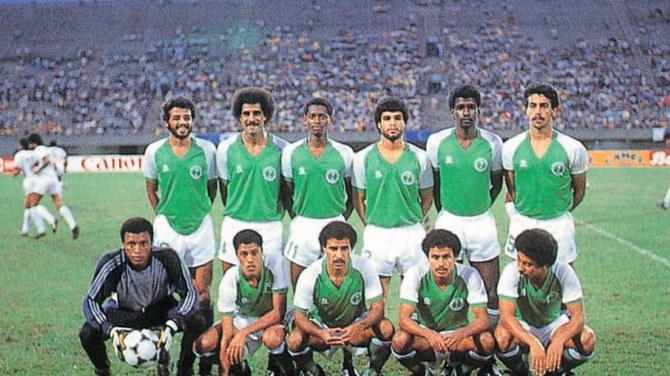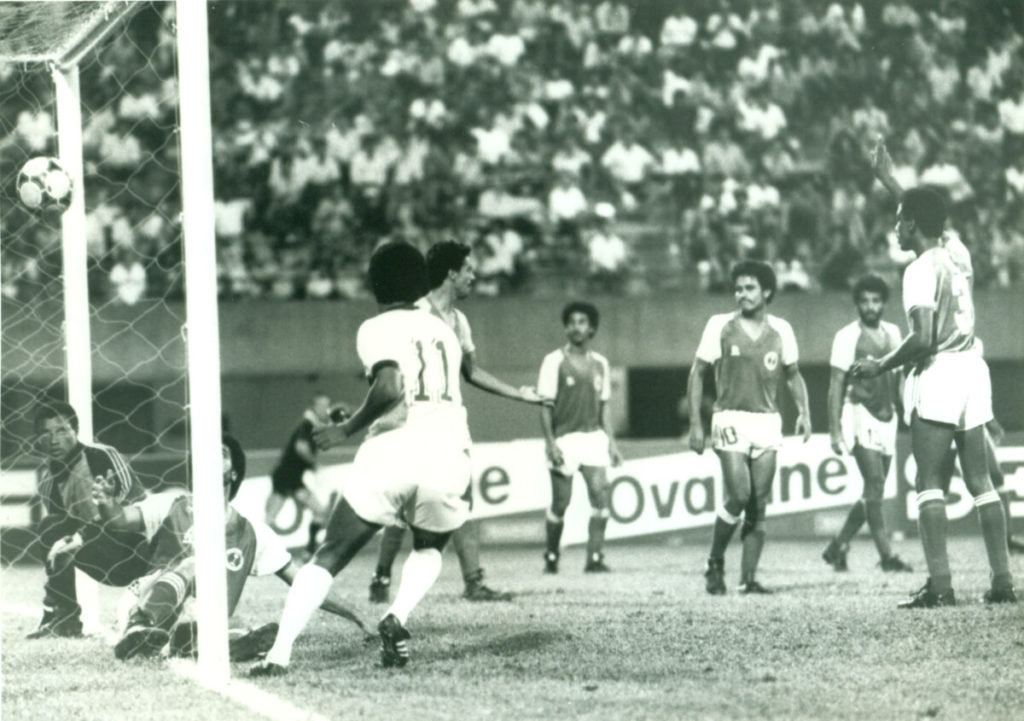The 1984 AFC Asian Cup found a home in Singapore as they stepped up to host the competition for the first time, with all games taking place over a 15-day period at the National Stadium in Kallung.
1984 AFC Asian Cup
Winner: Saudi Arabia
Runner-up: China PR
Hosts: Singapore
Singapore qualified as hosts, also qualifying for their first tournament, with Kuwait returning as defending champions. With the tournament again a 10-team tournament, this left eight places from the qualification tournament, which formed four round-robin groups.
Qualification saw the largest number of teams ever enter, although withdrawals once again forced changes in plans, with eight teams pulling out before a ball had been kicked.
In Group 1, only Burma pulled out, so six teams played a qualifying tournament in Indonesia for the two available places. The hosts were unlucky to miss out after losing 2-1 to Syria in the last group game, which left both sides on the same number of points and goal difference, but Syria heading for the finals as they had scored three more goals.
They finished second behind a dominant Iran team who, despite the lack of emphasis on sport in the country following the Islamic Revolution and the on-going Iran-Iraq war, won every game and scored 21 goals in the process to ensure their return to the Asian Cup finals.
In Group 2, five teams played a qualifying tournament in Saudi Arabia, with the hosts establishing themselves as the team to beat with a 7-0 win against Nepal and going on to secure four wins from four games with 19 goals scored and none conceded, qualifying them for their second cup, but first proper after withdrawing in 1976.
The only team to get close to them was the United Arab Emirates who lost 1-0 to the Saudis, but then scored 24 goals against Sri Lanka, Oman and Nepal to seal the other qualification place.
In Group 3, India and Malaysia were not originally drawn to play in this group, but withdrawals by Bahrain, Japan, Lebanon and Macau and the removal of Singapore due to their automatic qualification meant that they helped increase the competition to five teams.
India hosted the tournament and sealed their second qualification for the Asian Cup after beating North Yemen, Malaysia and neighbours Pakistan. They finished behind South Korea, who won the group after beating India 1-0 in the final game.
Finally, Group 4 saw Brunei, Iraq and South Yemen pull out before the qualifying tournament in China, which left Afghanistan, China PR, Hong Kong, Jordan and Qatar to battle for the two places.
As it was, after China PR and Qatar opening with heavy wins over Afghanistan, it became clear that they were the strongest teams in the competition and so it proved as by the time they played each other in their final group games, China PR and Qatar had already secured qualification, with China PR winning the group after Zhao Dayu’s 88thminute winner.
It was the Qataris who helped open the tournament, taking on Syria on 1st December in a 1-1 draw that set the tone for both teams during Group A as they both managed to beat South Korea, but dropped points against Saudi Arabia and Kuwait that left them unable to qualify for the knock-out stages.
For South Korea, these defeats were tough to take as they also drew with Saudi Arabia after conceding a late equaliser, then held Kuwait to a goalless draw, so finishing bottom of the group was not what they expected from their Asian Cup.
Saudi Arabia won the group after beating their fellow Arabian Gulf brethren Kuwait with a late Al-Jam’an goal, leaving the defending champions in second place after a less than convincing group stage performance.
Group A saw a tournament debut by Singapore and they started strongly, beating India 2-0 in front of 21,000 people. This proved to be a false dawn, however, and two defeats by China PR and the UAE put them out, although they salvaged some pride with a 1-1 draw against Iran.
This draw was more damaging for Iran, who started strongly with a 3-0 win against UAE and 2-0 against China PR, but they then drew 0-0 with India and while the draw against Singapore ensured qualification for the Semi-finals, they also knew that a heavy Chinese win against the UAE would leave them facing Saudi Arabia in the Semi-Finals.
China and UAE had both shaken off their opening defeats by Iran to put away India and Singapore and it was expected to be a tight and tense game with a win for either side putting them through, so it was a real surprise when China PR then absolutely outplayed UAE to win 5-0 and top the group on goal difference.
This set two high profile Semi-finals with Iran taking on Saudi Arabia and China PR facing the holders Kuwait and both games proved to be epic encounters that went the distance.
Iran looked to have done enough to put out the powerful Saudis when Shahrokh Bayani put them ahead just before half-time, but the pressure by Saudi Arabia paid off when Shahin Bayani put through his own net to level the scores up with just two minutes remaining.
30 minutes of extra-time couldn’t separate the sides, so the game was decided on penalties, with the Saudis making their first final after scoring all five of their penalties, while Seyed Panjali was the unfortunate man to miss for Iran, putting a delighted Saudi team through to their first Asian Cup final.
China PR and Kuwait took to the field the next day for the second Semi-final. It proved as a tense and tight a game as the day before with chances at a premium and, at the end of 90 minutes, neither side could find an opening.
It seemed like one goal would be enough to win it and this proved the case as Li Huayun slotted home after 108 minutes to put the holders out and send China PR through to the final for the first time.
Kuwait and Iran played out a dour third-place playoff two days later, with Kuwait winning 5-3 on penalties after a 1-1 draw.
This set the scene for a new champion to be crowned as Saudi Arabia and China PR entered the National Stadium in front of 26,000 fans to play for the right to become champions of Asia.
With so much at stake, the first goal could prove to be the most vital and this was proved by Shaye Al-Nafisah, who volleyed home from outside of the area to give the Saudis the lead after just 12 minutes.
It left China PR chasing the game for large periods of time, but without successfully finding a way through. It was Saudi Arabia instead who scored the second and decisive goal when Majeh Ahmed Abdullah scored a memorable goal after dribbling from the halfway line through the Chinese defence. It was a brilliant goal and a suitable full stop to Saudi Arabia’s first Asian Cup win.




